Over the last 20 years here in New Mexico, I’ve used awls for everything from stitching a saddle bag to marking dovetail joints in mesquite wood.
They’re as at home in a leather shop as they are in a camping kit. But with their versatility comes the need for care, skill, and respect and that’s where Awl Tool Uses Guidelines come in.
In this guide, I’ll share 18 different types of Awl Tool Uses & 7 safety tips, how to keep them sharp and which ones to buy here in the USA.
Table of Contents
18 Types of Awl Tool Uses Guidelines
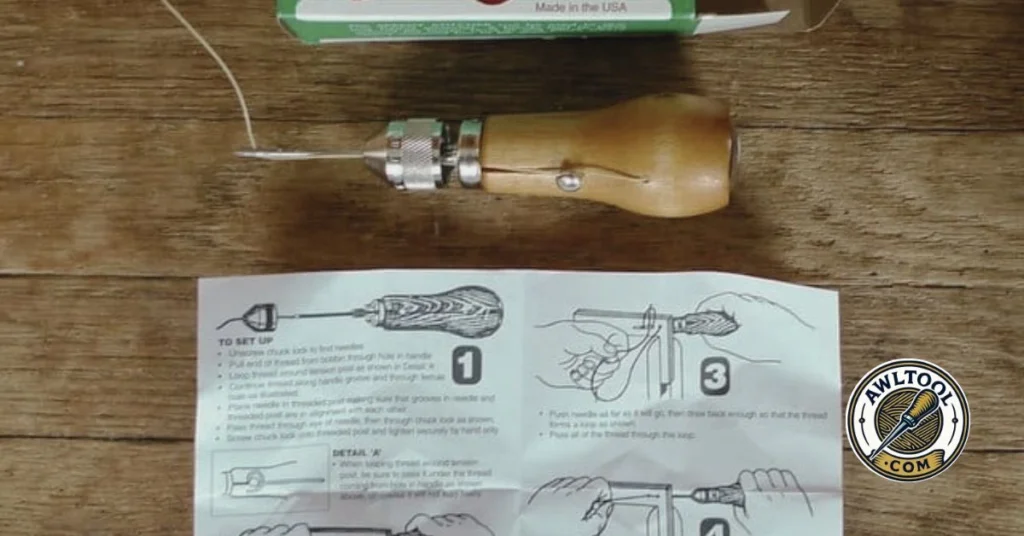
Over the years, I’ve seen more botched holes, frayed threads, and sore fingers from using the wrong awl than I can count.
Here are my personal, Awl Tool Uses Guidelines for 2025, along with the 18 types of awls every serious craftsperson should know.
| Awl Type | Awl Tools Use | Awl Tools Tip |
| 1. Scratch Awl | Marks precise lines on wood, leather, or metal for crafters; essential for layout in woodworking and leatherworking projects. | Keep sharp for clean marks; use light pressure on soft materials. |
| 2. Stitching Awl | Pierces leather for saddle stitching in leatherworking; creates clean holes for hand-stitched wallets, belts, and bags. | Push straight, avoid twisting to maintain strong, clean stitch holes. |
| 3. Collar Awl | Reaches deep seams in saddle, harness work for leatherworkers; ideal for thick hides in traditional tack crafting. | Use mallet on tough leather; avoid hand-forcing to prevent damage. |
| 4. Lacing/Stitching Fid | Enlarges holes for leather lacing in crafting; used in belts, bags, and decorative leather projects for hobbyists. | Don’t overstretch holes; use gently to preserve leather strength. |
| 5. Diamond-Shaped Awl | Creates clean diamond holes for stitching in leatherworking; prevents thread wear in wallets, journals, and saddles. | Match blade to thread size for perfect, durable stitching holes. |
| 6. Blunt Awl | Positions fabric, aids bookbinders and tailors; ideal for delicate silk or thin leather without cutting fibers. | Use short pushes on delicate fabrics to avoid fraying or tears. |
| 7. Leather Awl | Pierces leather cleanly for USA artisans; used in handcrafted bags, shoes, and belts without tearing vegetable-tanned leather. | Lubricate with beeswax for smooth piercing; clean after each use. |
| 8. Wood Awl | Starts screw or nail holes in woodworking; prevents splitting in furniture, cabinets, and carpentry projects. | Go with wood grain to avoid splits; keep tip sharp always. |
| 9. Bone Awl | Used in traditional crafts, basketry; pierces textiles, soft fibers for weaving or primitive tool work. | Use on soft fibers to avoid marring; store carefully. |
| 10. Speedy Stitcher Sewing Awl | Repairs heavy canvas, leather, nylon for DIYers; perfect for tents, upholstery, and outdoor gear fixes. | Carry spare needles, waxed thread for quick, reliable field repairs. |
| 11. Clover Straight Tailor’s Awl | Pierces, guides fabric for USA tailors; marks patterns, creates buttonholes in denim, silk, or canvas garments. | Use controlled, short pushes to prevent fraying delicate fabrics. |
| 12. Awl Haft | Holds interchangeable awl blades for crafters; versatile for leather, wood, or fabric in multi-craft projects. | Keep multiple blades ready for quick switches between materials. |
| 13. Awl Needles | Carries thread for stitching awls in leatherwork; used in heavy-duty repairs for bags, saddles, upholstery. | Wax thread before stitching for smoother, stronger pulls through leather. |
| 14. Curved Awl | Reaches awkward spots in USA 3D leather or fabric projects; ideal for bags, shoes, or curved seams. | Practice control to prevent wandering in curved sewing projects. |
| 15. Tapered Awl | Enlarges holes gradually in bookbinding, leatherwork; aligns layers for journals, books, or layered crafts. | Use for precise layer alignment; avoid over-enlarging holes. |
| 16. Round Blade Awl | Creates smooth, round holes in leather, fabric; perfect for eyelets in belts, bags, or canvas projects. | Ideal for clean eyelet holes; keep blade sharp for precision. |
| 17. Square Awl | Makes square starter holes in woodworking; prevents splitting in furniture, frames, or carpentry tasks. | Align with grain to prevent wood splitting; sharpen regularly. |
| 18. Bookbinding Awl | Punches precise sewing holes in paper signatures for bookbinders; used in journals, coptic bindings. | Use with a cradle for accurate, tear-free holes in paper. |
What is an Awl Tool?
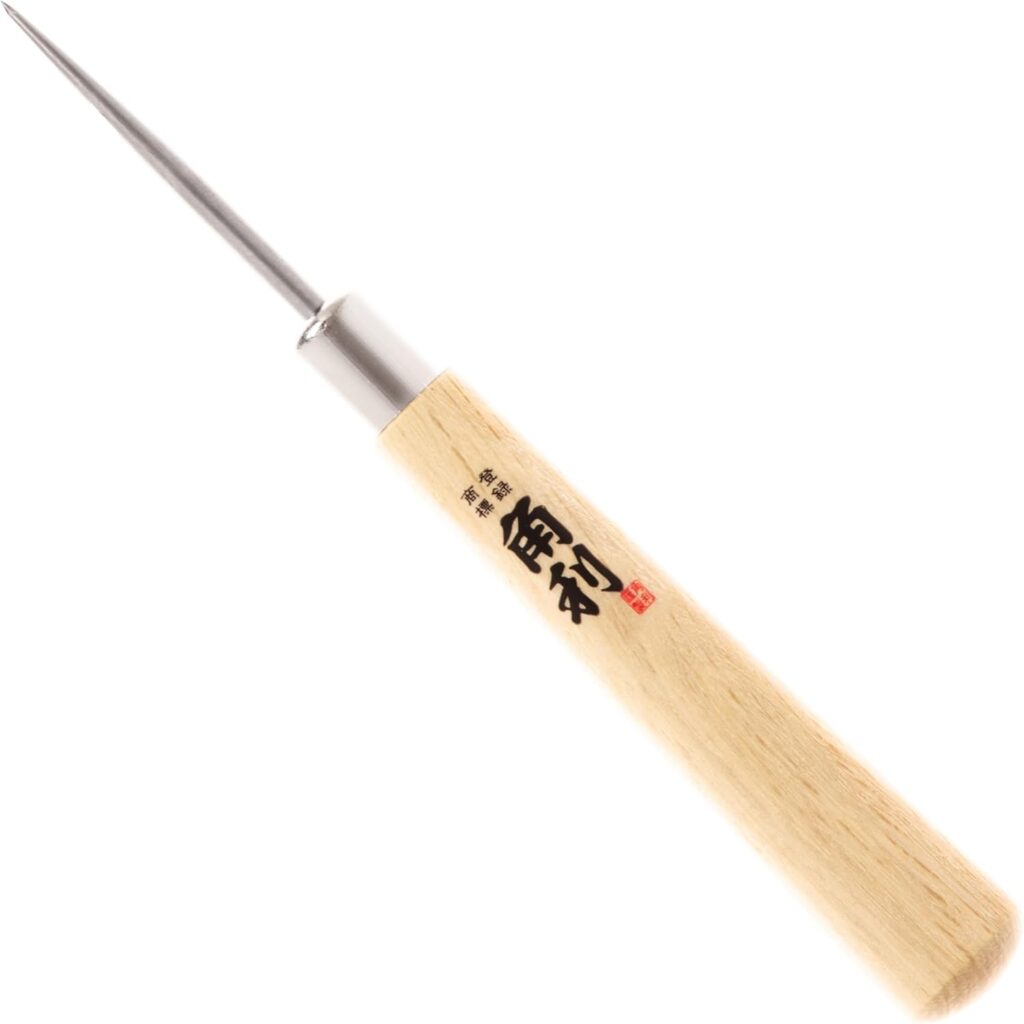
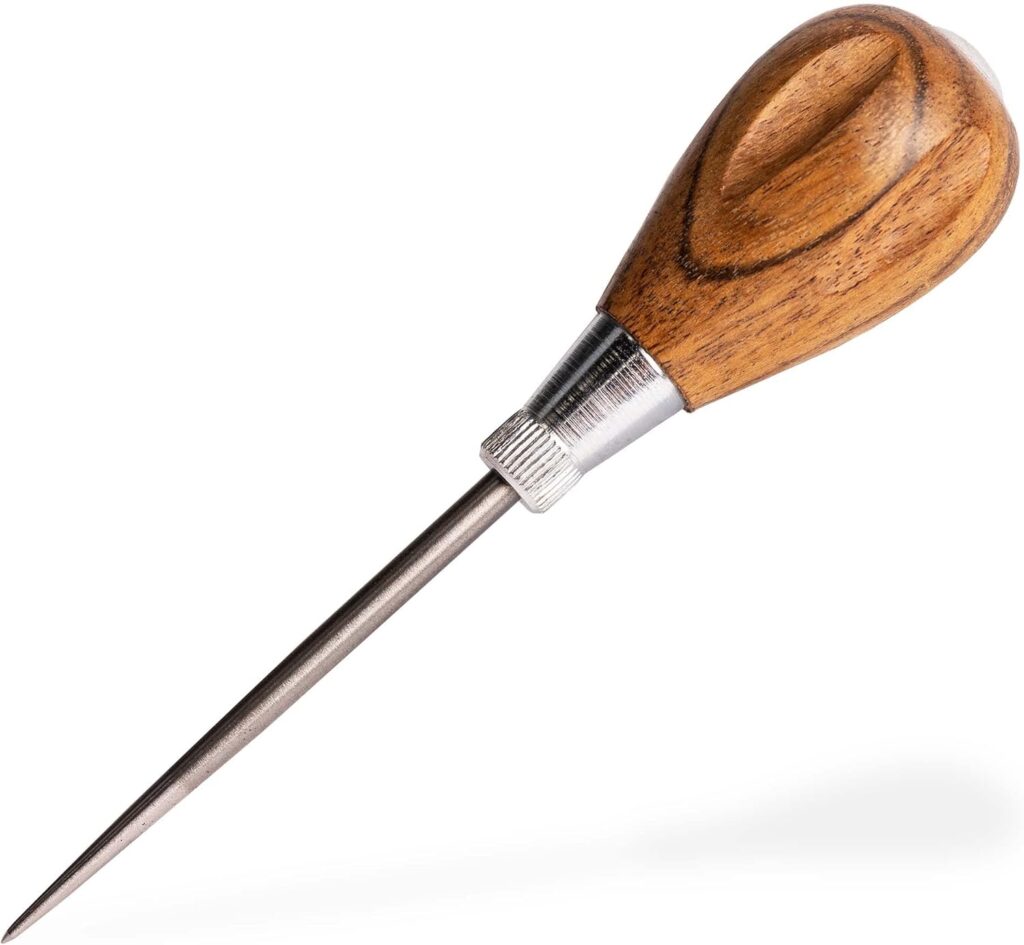
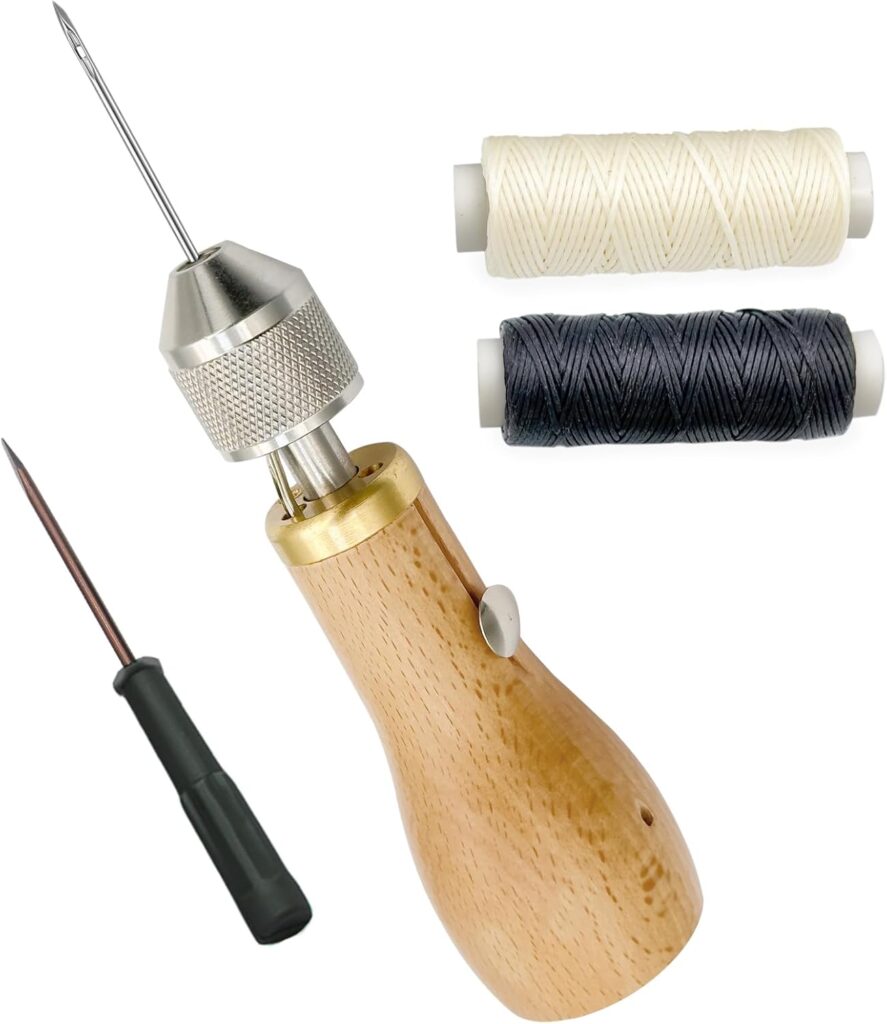
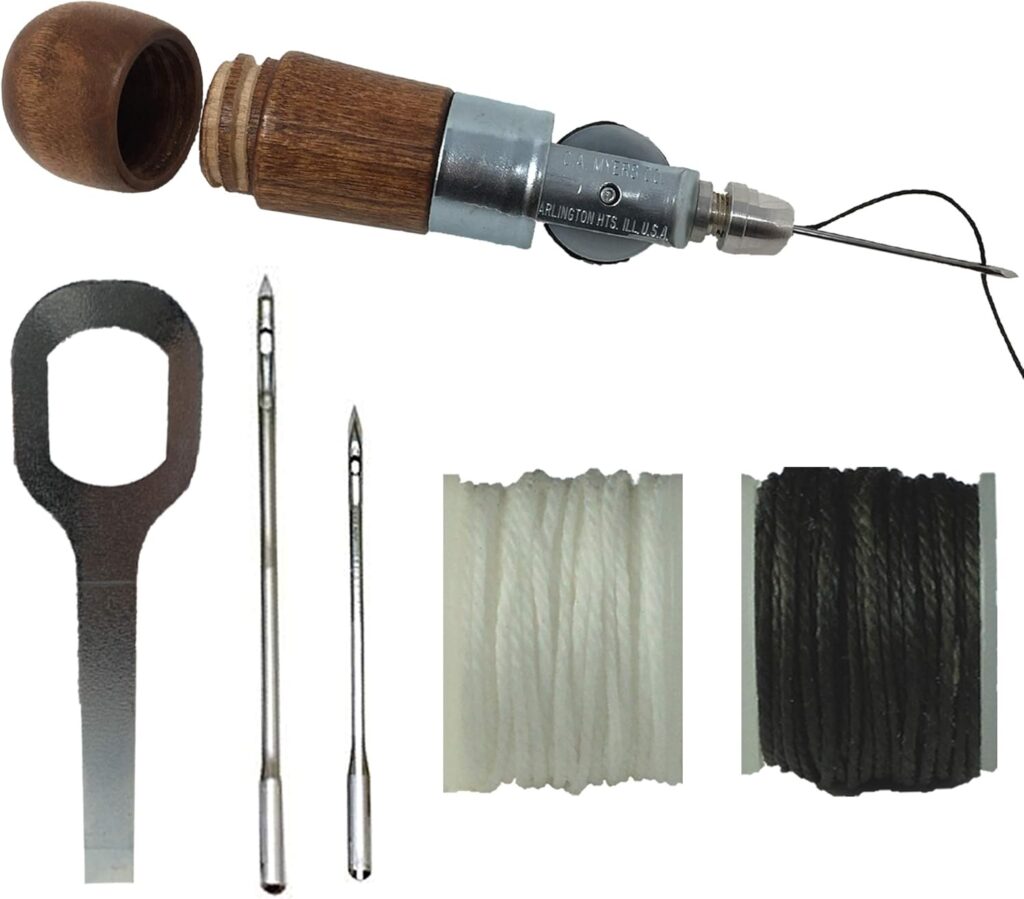
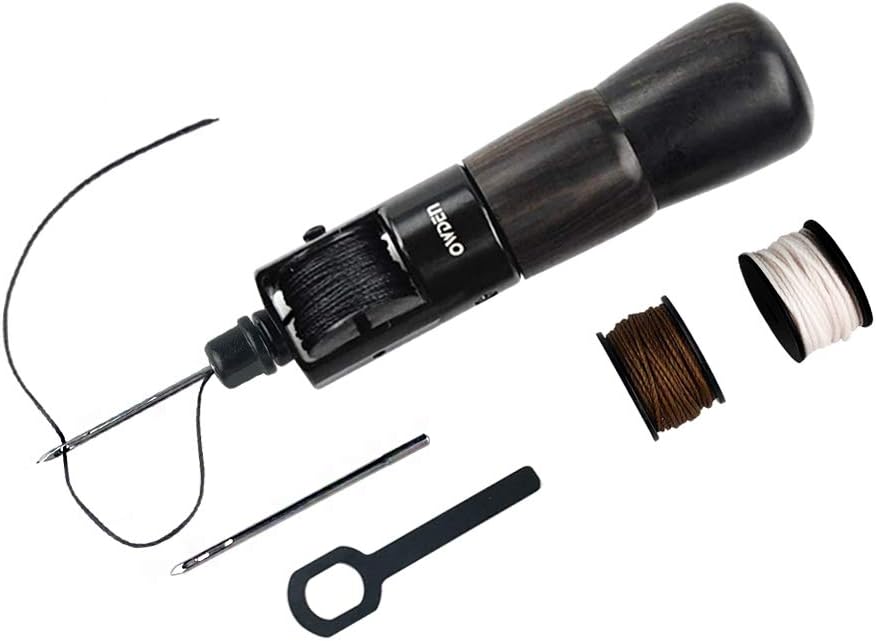
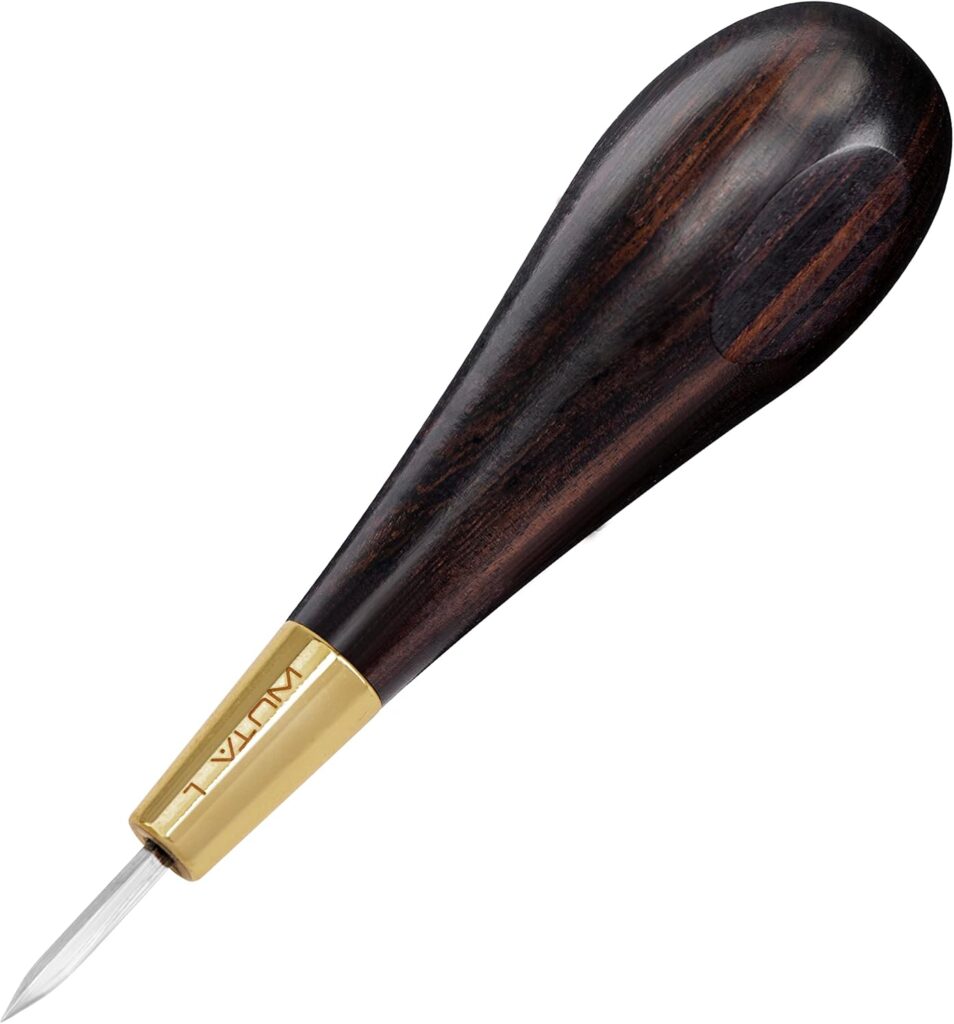
It’s a precision hand tool with one core job: making a hole or a mark exactly where you need it.
An awl is a simple hand tool: a handle, usually wood or composite, fitted with a sharp metal shaft. The tip shape changes with the job, diamond for leather stitching, round for fabric work, chisel for heavy piercing.
The main categories include:
- Leather Awl: for piercing and stitching guides.
- Stitching Awl: often used with thread for sewing heavy materials.
- Woodworking Awl: for marking and starting holes in timber.
- Quilting/Tailor’s Awl: for fabric manipulation and opening buttonholes.
Handles range from polished rosewood to injection-molded grips. The steel may be high-carbon, stainless, or specialty alloys.
Core Guidelines for All Awls:
- Match the awl to the material: The right tip shape and size make the difference between clean work and ruined stock.
- Work on a stable surface: Cutting mats for leather/fabric, bench tops for wood.
- Control depth and angle: Especially in leather and fabric where over-penetration can weaken seams.
- Keep it sharp: Dull awls require more force, which means less control and more injuries.
- Respect the point: Always cap or sheath when not in use.
- Practice before the real project: Scrap pieces are your friends.
When I’m working in my shop in Albuquerque, I keep at least five awls within arm’s reach. Each one has a job, and I don’t mix them up, my diamond awl never touches fabric, my blunt awl never sees wood.
That discipline keeps my work clean and my tools lasting for years.
Essential Uses of Awl Tools
Awls are the definition of versatility:
- Leatherwork: Punching holes, guiding saddle stitches, marking patterns.
- Woodworking: Marking drill points, scoring lines for joinery.
- Sewing/Crafts: Opening buttonholes, aligning fabric layers.
- Repairs/Survival: Fixing gear, piercing canvas, even making traps in the wild.
Best Awls by Job
- Beginners: Scratch awl, round blade awl
- Woodworking: Marking awl, square awl
- Leatherworking: Diamond awl, stitching awl
- Bookbinding: Bookbinding awl, tapered awl
- Tailoring: Clover straight tailor’s awl, blunt awl
- Crafting: Curved awl, lacing/stitching fid
- Specialty: Bone awl (primitive crafts), speedy stitcher for repairs
Awl Safety Guidelines
The first time I slipped with an awl, it was 2008, and I was rushing to finish a saddle repair before a storm rolled in. My diamond awl went right past the stitch line… and into my thumb. A drop of blood on vegetable-tanned leather is a sight you don’t forget.
7 Safety Tips
- Grip like you mean it: Hold the awl like a pencil, with fingers behind the point of entry. Never push toward your other hand.
- Set your stance: Feet shoulder-width apart, elbows anchored. If you’re off balance, you’re off target.
- Use a stable surface: Cutting mats for leather, punching cradles for bookbinding, solid benchtops for woodworking.
- Protect your hands: Light leather gloves can
- save you from slips without sacrificing control.
- Match awl to job: Forcing a fabric awl into hardwood is asking for trouble.
- Cap it: A simple cork or sponge over the tip saves accidents in the shop and the toolbox.
Awl Tool Maintenance & Longevity Tips
A sharp, clean awl is a joy to use. A dull, rust-speckled one? That’s a liability.
My routine after every project:
- Wipe the blade: Even stainless steel can pit; I use a microfiber cloth and a drop of camellia oil.
- Check alignment: If the tip has bent, I straighten it gently with smooth-jaw pliers.
- Sharpen and strop: For diamond and scratch awls, I use a fine whetstone, followed by a leather strop charged with compound.
- Handle care: Wooden handles get beeswax or tung oil once a year.
Rust prevention is key in dry states like New Mexico, but especially if you live near the coast. Store awls in a dry box or wrapped in oiled cloth.
Troubleshooting common problems:
- Loose handle ferrule: A dab of epoxy will keep the blade tight.
- Bent tip: If badly damaged, replace, straightening weakens the steel.
- Rust: Remove with 0000 steel wool and oil.
Common Mistakes to Avoid
- Using a dull awl: It’s not “safer,” it’s just more dangerous in slower motion.
- Wrong awl for the material: Leads to frayed fabric, split wood, or torn leather.
- Over-penetrating: Especially in leather, this makes stitches loose.
- Skipping maintenance: Neglect is the fastest way to ruin a tool.
- Improvising uses: An awl is not a screwdriver, pry bar, or ice pick.
Awl Tool Buying Guide for the USA
After two decades, I’ve narrowed my trusted list to a handful of brands and shops.
What to look for:
- Comfortable, shaped handle that fits your grip.
- High-carbon or stainless steel with proper temper.
- Replaceable or serviceable tips.
- USA-based suppliers with good return policies.
Brands I trust:
- C.S. Osborne & Co.: Made in the USA, legendary quality.
- Tandy Leather: Reliable for leather awls and beginner kits.
- WUTA: Excellent diamond awls for leathercraft.
Where to buy in the USA:
- Local craft fairs (Santa Fe Artisan Market is my favorite).
- Hardware stores with woodworking sections.
- Specialty online shops like – Best Awl Tool in 2025.
Awl Tool Projects and Applications
- Leather Wallet: Use a diamond awl to pierce holes before saddle stitching.
2. Wood Joinery: Mark dovetail baselines with a scratch awl for crisp cuts.
3. Bookbinding: Punch sewing stations with a bookbinding awl and cradle.
4. Sewing Repairs: A blunt tailor’s awl helps align layers without damage.
One of my favorite memories is repairing my father’s old canvas tool roll with a speedy stitcher during a camping trip in northern Arizona. We sat under the pines, thread and awl in hand, and by nightfall it was as good as new.
Frequently Asked Questions
1. When should I use an awl instead of a needle or drill?
1. When precision and control matter more than speed.
2. When you want to avoid splitting fibers or grain.
2. How do I prevent awl-related injuries?
1. Keep both hands behind the tip.
2. Work slowly and deliberately.
3. Store capped or in a sheath.
3. What is the best way to sharpen and maintain my awl?
1. Fine whetstone for shaping.
2. Leather strop for polishing.
3. Light oil to prevent rust.
4. Where can I buy quality awls in the USA?
Best Awl Tool in 2025
C.S. Osborne & Co.
Tandy Leather
5. Can an awl be used in survival and outdoor scenarios?
Yes — for shelter building, gear repair, trap-making, and even fire-starting prep.
Conclusion
If you’ve read this far, you already understand why I call the awl the “quiet king” of the workshop. It’s simple, versatile, and in the right hands, almost irreplaceable.
The Awl Tool Uses Guidelines aren’t just about avoiding mistakes. They’re about getting the cleanest stitch, the straightest mark, the most satisfying “pop” as the tip pierces perfectly through your material.
So pick up a good one, keep it sharp, and treat it with respect. You’ll be surprised just how often it earns its place in your hand.
What’s your favorite way to use an awl? Share your stories with me here: Crafting Community.
Join the conversation on Instagram and Facebook: Share your favorite marking or drilling tools and tag us to get featured!
As one longtime Klein awl owner said: “I’m sure had I not lost it, it would have outlasted me. Glad to see it’s still made.”
My Philosophy on Awl Use: When I teach beginners at local workshops in Albuquerque, I tell them: An awl is an extension of your fingertips — precise, patient, and unforgiving if rushed. Good awl work is about control, not brute force.
Learn More:
- What Kind of Tools Are Center Punch and Scratch Awl? 2025
- What Is the Job of the Worker Who Uses a Tool Called an Awl? (2025)
- Best 5 Score Awl Tool Wilmington NC – Expert Reviews & Buying Guide 2025

About Writer
Hi, I’m Nicholas N. Goforth, a New Mexico crafter with 20 years of experience in leatherworking, woodworking, and bookbinding.



